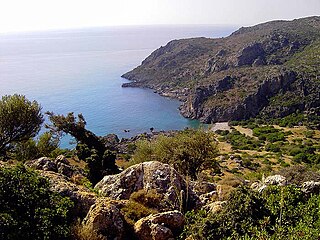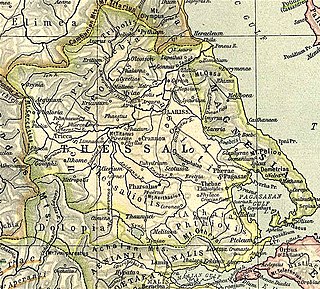
In Roman religion, the genius is the individual instance of a general divine nature that is present in every individual person, place, or thing. Much like a guardian angel, the genius would follow each man from the hour of his birth until the day he died. For women, it was the Juno spirit that would accompany each of them.

The gens Aquillia or Aquilia was a plebeian family of great antiquity at ancient Rome. Two of the Aquillii are mentioned among the Roman nobles who conspired to bring back the Tarquins, and a member of the house, Gaius Aquillius Tuscus, was consul in 487 BC.

Halaesa, also known as Halaesa Archonidea and also spelled Alaesa or Halesa was an ancient city of Sicily, situated near the north coast of the island, between Cephaloedium and Calacte.

Lissus or Lissos was a town on the south coast of ancient Crete, which the anonymous Stadiasmus Maris Magni places between Syia and Calamyde. The Peutinger Table gives 16 M.P. as the distance between Cantanum and Lissus. It was one of the harbours of Elyrus. It was established in the Classical period and flourished until the Late Antiquity. Its name was made certain by inscriptions. The early history of the city is unknown. Based on inscriptions and coins of the 3rd century BCE, we know the city allied with King Magas of Cyrene, and joined the League of Oreians. The koinon of the Oreians consisted of the cities Lissus, Syia, Poikilassos, Tarrha, Yrtakina and Elyrus. Lissus had powerful trading and fishing fleets.

Apamea Cibotus, Apamea ad Maeandrum, Apamea or Apameia was an ancient city in Anatolia founded in the 3rd century BC by Antiochus I Soter, who named it after his mother Apama. It was in Hellenistic Phrygia, but became part of the Roman province of Pisidia. It was near, but on lower ground than, Celaenae (Kelainai).

Docimium, Docimia or Docimeium was an ancient city of Phrygia, Asia Minor where there were famous marble quarries.

Heraclea, also Heracleia or Herakleia, was an ancient city of Magna Graecia. It was situated on the Gulf of Taranto between the rivers Aciris and Siris. The ruins of the city are located in the modern comune of Policoro in the Province of Matera, Basilicata, Italy.
Hybla Gereatis, was an ancient city of Sicily, located on the southern slope of Mount Etna, not far from the river Symaethus, in the modern comune of Paternò. There were at least three cities named "Hybla" in ancient accounts of Sicily which are often confounded with each other, and which it is sometimes very difficult to distinguish.

Carrawburgh is a settlement in Northumberland. In Roman times, it was the site of a 3+1⁄2-acre (1.5 ha) auxiliary fort on Hadrian's Wall called Brocolitia, Procolita, or Brocolita. This name is probably based on the Celtic name for the place, and one possible translation put forward is 'badger holes'. The fort there was a mile or so west of the Wall's northernmost point at Limestone Corner, and just over a mile west of the nearest milecastle, Milecastle 30. The fort either used the Wall itself as its northern rampart, or was built parallel to it but detached. It certainly postdates both the Wall and the vallum.
The gens Aelia, occasionally written Ailia, was a plebeian family in Rome, which flourished from the fifth century BC until at least the third century AD, a period of nearly eight hundred years. The archaic spelling Ailia is found on coins, but must not be confused with Allia, which is a distinct gens. The first member of the family to obtain the consulship was Publius Aelius Paetus in 337 BC.
The gens Pinaria was one of the most ancient patrician families at Rome. According to tradition, the gens originated long before the founding of the city. The Pinarii are mentioned under the kings, and members of this gens attained the highest offices of the Roman state soon after the establishment of the Republic, beginning with Publius Pinarius Mamercinus Rufus, consul in 489 BC.

The gens Fonteia was a plebeian family at ancient Rome. Members of this gens are first mentioned toward the end of the third century BC; Titus Fonteius was a legate of Publius Cornelius Scipio during the Second Punic War. The first of the Fonteii to obtain the consulship was Gaius Fonteius Capito, consul suffectus in 33 BC.

The gens Fundania was a plebeian family at Ancient Rome, which first appears in history in the second half of the third century BC. Although members of this gens occur well into imperial times, and Gaius Fundanius Fundulus obtained the consulship in BC 243, the Fundanii were never amongst the more important families of the Roman state.
The gens Iccia was a minor plebeian family at Rome. It is known primarily from a small number of individuals who lived during the first century BC, as well as a number of inscriptions from Gallia Narbonensis.
The gens Maenia, occasionally written Mainia, was a plebeian family at ancient Rome. Members of this gens are first mentioned soon after the establishment of the Republic, and occur in history down to the second century BC. Several of them held the position of tribune of the plebs, from which they strenuously advocated on behalf of their order. The most illustrious of the family was Gaius Maenius, consul in 338 BC, and dictator in both 320 and 314. In some manuscripts, the nomen Maenius appears to have been erroneously substituted for Menenius or Manlius; there are also instances of confusion with Manilius, Maelius, and Maevius.
The gens Numonia, occasionally written Nummonia, was a minor plebeian family at Rome. Members of this gens are first mentioned in the early years of the Empire. Few if any of the Numonii held any Roman magistracies.
The gens Pedia was a plebeian family at ancient Rome. Members of this gens are first mentioned in history during the final century of the Republic, and for the next two centuries they were distinguished in statesmanship, rhetoric, art, and law. The first of the Pedii to obtain the consulship was Quintus Pedius, the nephew of Caesar, in 43 BC.

The gens Pupia was a plebeian family at ancient Rome. Members of this gens are mentioned as early as 409 BC, when Publius Pupius was one of the first plebeian quaestors, but over the course of centuries they achieved little of significance, and rarely held any of the higher offices of the Roman state.

Cierium or Kierion was a town and polis (city-state) in the district of Thessaliotis in ancient Thessaly, which according to some ancient commentators, such as Stephanus of Byzantium was the successor to the Homeric Arne, the chief town of the Aeolian Boeotians in Thessaly, from which they emigrated to Boeotia.
Lappa, or Lampa (Λάμπα), or Lampae or Lampai (Λάμπαι), or Lampe (Λάμπη), was an inland town of ancient Crete, with a district extending from sea to sea, and possessing the port Phoenix. Although the several forms of this city's name occur in ancient authors, yet on coins and in inscriptions the word Lappa is alone found. Stephanus of Byzantium shows plainly that the two names denote the same place, when he says that Xenion, in his Cretica, wrote the word Lappa, and not Lampa. The same author says that it was founded by Agamemnon, and was called after one Lampos, a Tarrhaean; the interpretation of which seems to be that it was a colony of Tarrha.












